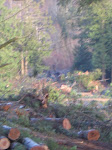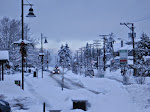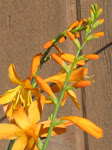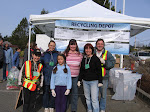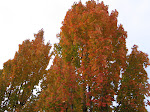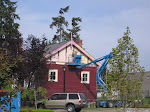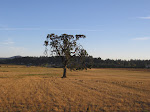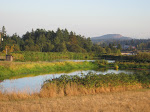Municipal Mail in Ballots
-with thanks to Sara Ribeiro at Central Saanich Municipal Hall
In July, a report was presented to Central Saanich Council with an accompanying Election Procedures Bylaw to incorporate mail-in ballot voting and mobile voting for the 2008 local government election. Below is an excerpt from that Bylaw pertaining to mail-in ballot voting for your information. Please note S. 16 which stipulates who may participate in the mail-in ballot voting opportunity.
PART 3 – MAIL BALLOT VOTING
Authorization
16 An elector who:
(1) has a physical disability, illness, or injury that affects his or her ability to vote at another voting opportunity, or
(2) expects to be absent from the District on general voting day and at the times of all advance voting opportunities may vote by mail ballot.
Application procedure
17 A person wishing to vote by mail ballot may apply in writing by providing their name and address to the Chief Election Officer, during the period commencing seven (7) days before the first day of advance voting and ending at 4:00 p.m. on the date two (2) days before general voting day.
18 Upon receipt of a request for a mail ballot, the Chief Election Officer shall, between the first day of advanced voting and 4:00 p.m. on the date two (2) days before general voting day:
(1) make available to the applicant by mail or in person, a mail ballot package containing the ballots, forms, envelopes and other documents required under the Local Government Act ; and,
(2) immediately record and, upon request, make available for inspection the name and address of the person to whom the mail ballot package was issued; and,
Voting procedure
19 In order to be counted for an election, an elector’s mail ballot must be mailed or delivered to the Chief Election Officer at the address specified on the outer envelope provided in the mail ballot package so that it is received no later than the close of voting on general voting day.
Ballot acceptance or rejection
20 Upon receipt of mail ballot packages before the close of voting on the general voting day, the Chief Election Officer shall record the time and date of its receipt and shall examine the certification envelope.
21 If the Chief Election Officer is satisfied as to:
(1) the identity and entitlement to vote of the elector whose ballot is enclosed; and
(2) the completeness of the certification, the Chief Election Officer shall mark the certification envelope as “accepted” and shall mark the voting book to indicate that the elector has voted.
22 The unopened certification envelopes marked as “accepted” shall remain in the custody of the Chief Election Officer until the close of voting on general voting day, at which time the Chief Election Officer shall, in the presence of at least one other election official, in addition to any scrutineers present:
(1) open the certification envelopes;
(2) place the unopened secrecy envelopes together into a ballot box;
(3) open the secrecy envelopes and remove the ballots within; and
(4) insert the ballots into the vote counting unit.
23 The Chief Election Officer shall retain all certification envelopes together with the voting books and for the purposes of document retention and destruction shall treat the certification envelopes in the same manner as a voting book.
24 If:
(1) upon review of an outer envelope, the Chief Election Officer is not satisfied as to the identity of the elector whose ballot is enclosed or the completeness of the certification; or
(3) the outer envelope is received by the Chief Election Officer after the close of voting on general voting day, the certification envelope shall remain unopened and the Chief Election Officer shall mark such envelope as “rejected” and shall note the reasons for the rejection..
25 Any certification envelopes and their contents rejected in accordance with Section 24 of this Bylaw shall remain unopened and shall not be counted in the election.
Challenge of elector
26 Between the time an elector requests a mail ballot package and the time that the mail ballot package is hand delivered or mailed to the elector requesting it, the elector’s right to vote may be challenged under section 116 of the Local Government Act.
Replacement of spoiled ballot
27 Where an elector unintentionally spoils a mail ballot before returning it to the Chief Election Officer, the elector may request a replacement ballot by advising the Chief Election Officer of the ballot spoilage and by mailing or otherwise delivering by any appropriate means, the spoiled ballot package in its entirety to the Chief Election Officer.
28 The Chief Election Officer shall, upon receipt of the spoiled ballot package, record such fact and issue a new mail ballot package to the elector.
For more info call Central Saanich Municipal hall at 652-4444 or check out the website:
http://www.centralsaanich.ca/hall/Departments/Administration/election.htm
Tuesday, August 19, 2008
Monday, August 18, 2008
Published on Monday, August 18, 2008 by the Seattle Post-Intelligencer
Loss Looms in Seattle’s Urban Forests
by Nancy Dickeman
Fir, cedar, pine: trees that tower, weaving a grove, bringing us the forest. Willow, ash, birch, elm: trees that bend to the wind, the gusts spinning branches. Apple, hawthorn, dogwood, plum: bearers of blossoms and fruit.
This is the litany of trees that carry wind through branches and cradle the nests of birds.These are trees that have come of age, the trunk’s rings telling their years, that in Seattle are disappearing by human design. City leaders boast of a goal for 30 percent tree canopy, yet strive towards it with the curious strategy of deforestation, followed by the planting of saplings.In this scheme, trees and forests are not treasured for their intrinsic value, for their role as anchors in a chain of habitat.
The role a mature tree plays in stemming climate change is dismissed with a wink and a nod to the new shoots of saplings — 70 times less effective in their role in reducing pollution. Little heed is given to the fact that thoughtless new construction abets the forces of climate change.
Beyond the service trees provide us is the home they make to wildlife. In the Maple Leaf neighborhood, near Waldo Woods, I watched an eagle land on the tallest fir. Waldo Woods is one of Seattle’s three remaining urban forests. On land once owned by Camp Fire, and the site of the former Waldo Hospital, much of the forest is slated for clearcutting, making way for new town home construction. While the developer touts that part of the grove will be saved, there is no mention that 72 trees will be lost, nor concern for the fate of the remaining trees. Once the interlocked system of roots is broken, the trees left behind are imperiled by the loss of their collective whole.
North of Maple Leaf, at Ingraham High School, a second remaining urban forest is scheduled to be torn down as part of the high school’s renovation. Despite available land on-site that would avoid the trees’ destruction, the renovation’s design zeroed in not only on requiring new construction but also on the specific piece of land where 84 trees stand. The school district and the city seem indifferent to tearing them out.
These native forests — that have grown over decades, extending from the land, forming a silhouette in the sky, protecting our air and water — cannot be replicated by saplings that will take decades to mature. They are ornamentals often chosen to match a designer’s cardboard visions, more suitable for blueprints than neighborhoods.An Eastern Washington judge recently sentenced a citizen to prison for the destruction and theft of dozens of mature cedars, saying “it is like stealing a part of the history of our country.”
Yet in Seattle, the mayor, Seattle Public Schools and Camp Fire, conjoined with developers, are all too eager to raze two of three of our city’s remaining urban forests, to steal our history and the Earth’s riches, in the quest for excessive density and a quick buck.
Driving through Seattle, the city still hints of neighborhoods graced with green. Yet if we continue with plans to tear down these groves of trees, we will discover too late what it means to destroy something irreplaceable.
If we are not careful, we may turn the Emerald City into a barren city of asphalt and stone.Nancy Dickeman lives in Seattle.
©1996-2008 Seattle Post-Intelligencer
Loss Looms in Seattle’s Urban Forests
by Nancy Dickeman
Fir, cedar, pine: trees that tower, weaving a grove, bringing us the forest. Willow, ash, birch, elm: trees that bend to the wind, the gusts spinning branches. Apple, hawthorn, dogwood, plum: bearers of blossoms and fruit.
This is the litany of trees that carry wind through branches and cradle the nests of birds.These are trees that have come of age, the trunk’s rings telling their years, that in Seattle are disappearing by human design. City leaders boast of a goal for 30 percent tree canopy, yet strive towards it with the curious strategy of deforestation, followed by the planting of saplings.In this scheme, trees and forests are not treasured for their intrinsic value, for their role as anchors in a chain of habitat.
The role a mature tree plays in stemming climate change is dismissed with a wink and a nod to the new shoots of saplings — 70 times less effective in their role in reducing pollution. Little heed is given to the fact that thoughtless new construction abets the forces of climate change.
Beyond the service trees provide us is the home they make to wildlife. In the Maple Leaf neighborhood, near Waldo Woods, I watched an eagle land on the tallest fir. Waldo Woods is one of Seattle’s three remaining urban forests. On land once owned by Camp Fire, and the site of the former Waldo Hospital, much of the forest is slated for clearcutting, making way for new town home construction. While the developer touts that part of the grove will be saved, there is no mention that 72 trees will be lost, nor concern for the fate of the remaining trees. Once the interlocked system of roots is broken, the trees left behind are imperiled by the loss of their collective whole.
North of Maple Leaf, at Ingraham High School, a second remaining urban forest is scheduled to be torn down as part of the high school’s renovation. Despite available land on-site that would avoid the trees’ destruction, the renovation’s design zeroed in not only on requiring new construction but also on the specific piece of land where 84 trees stand. The school district and the city seem indifferent to tearing them out.
These native forests — that have grown over decades, extending from the land, forming a silhouette in the sky, protecting our air and water — cannot be replicated by saplings that will take decades to mature. They are ornamentals often chosen to match a designer’s cardboard visions, more suitable for blueprints than neighborhoods.An Eastern Washington judge recently sentenced a citizen to prison for the destruction and theft of dozens of mature cedars, saying “it is like stealing a part of the history of our country.”
Yet in Seattle, the mayor, Seattle Public Schools and Camp Fire, conjoined with developers, are all too eager to raze two of three of our city’s remaining urban forests, to steal our history and the Earth’s riches, in the quest for excessive density and a quick buck.
Driving through Seattle, the city still hints of neighborhoods graced with green. Yet if we continue with plans to tear down these groves of trees, we will discover too late what it means to destroy something irreplaceable.
If we are not careful, we may turn the Emerald City into a barren city of asphalt and stone.Nancy Dickeman lives in Seattle.
©1996-2008 Seattle Post-Intelligencer
Tuesday, August 12, 2008
People who will not sustain trees will soon live in a world which cannot sustain people.
-- Bryce Nelson
-- Bryce Nelson
Subscribe to:
Posts (Atom)





